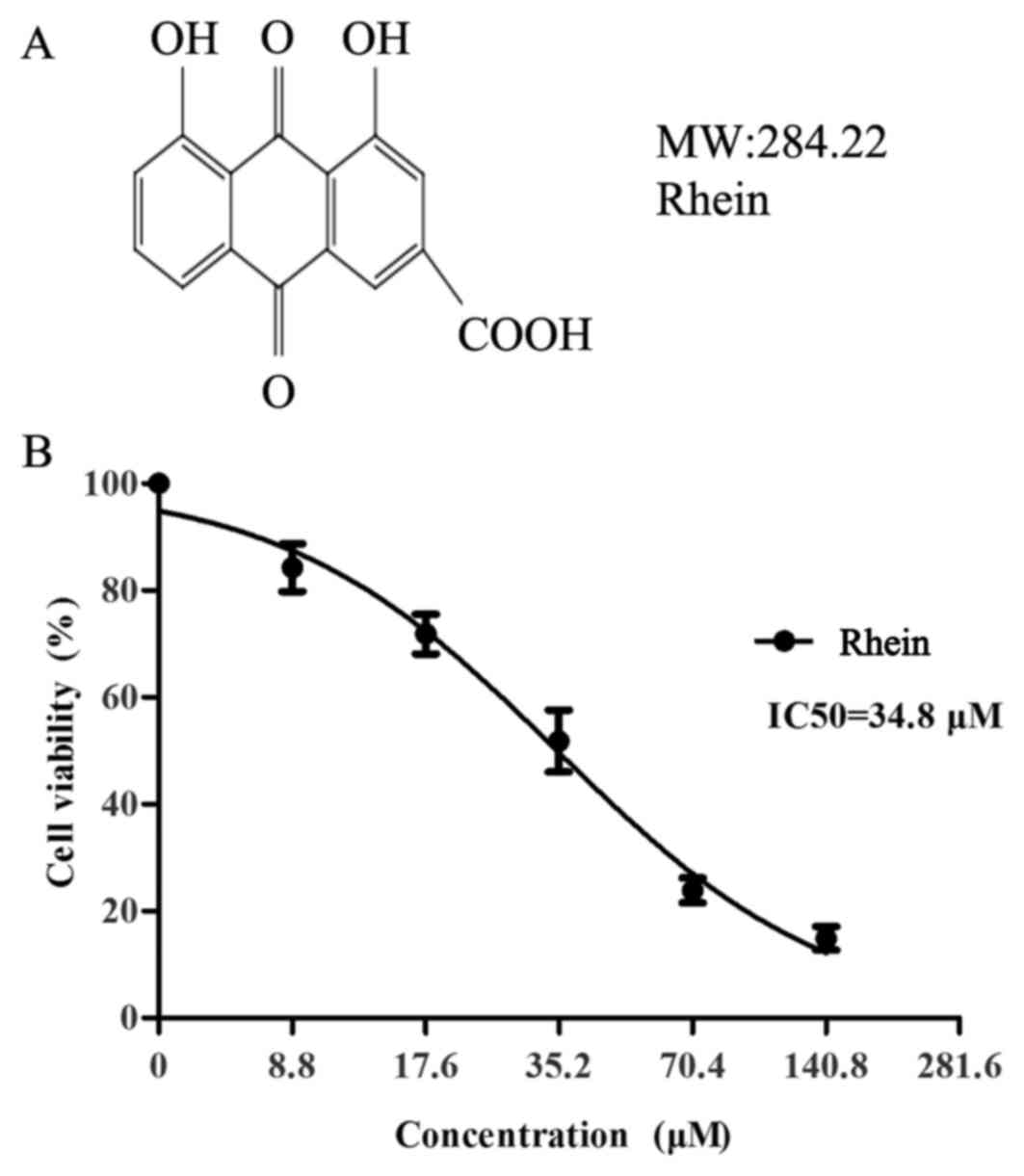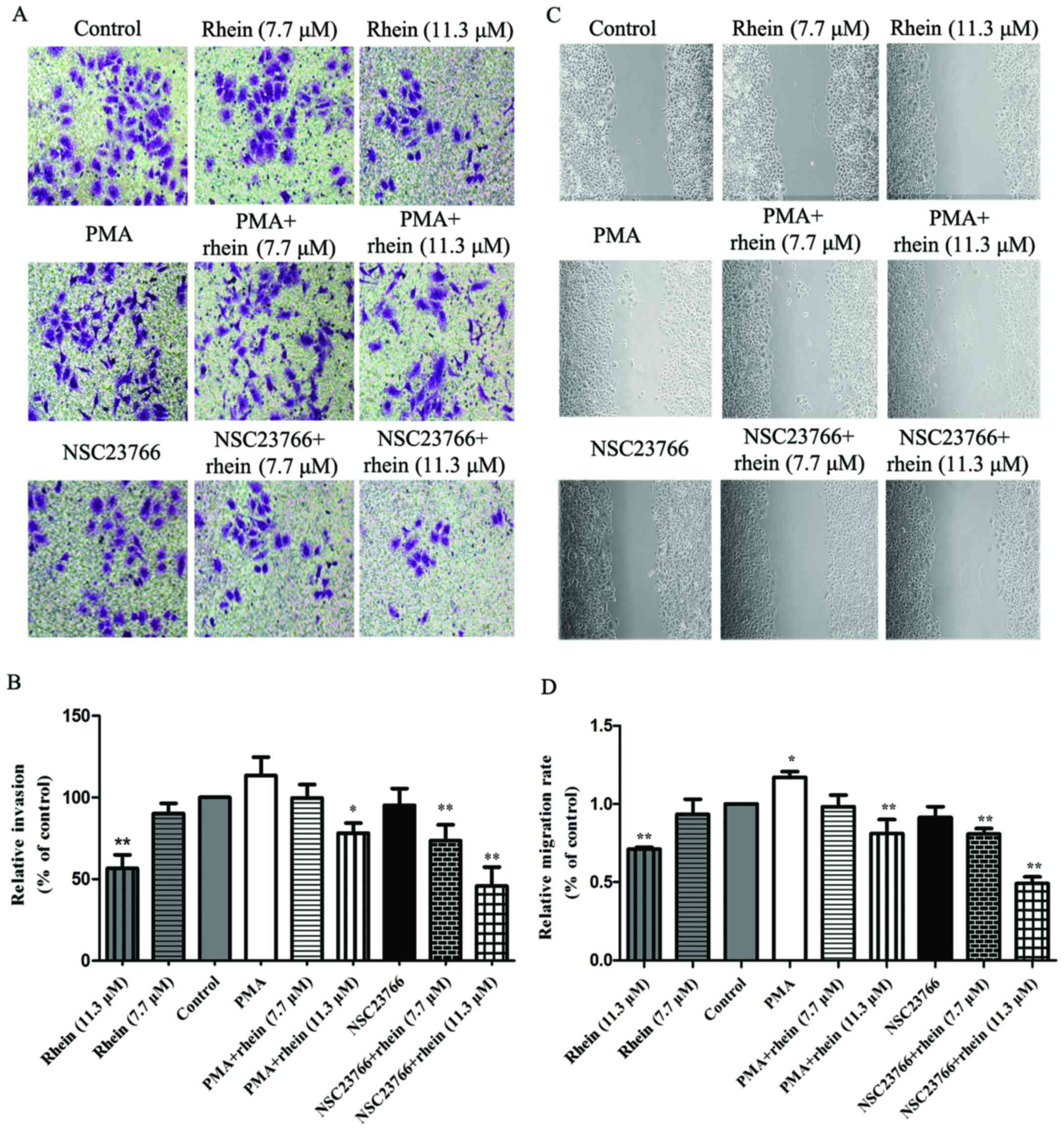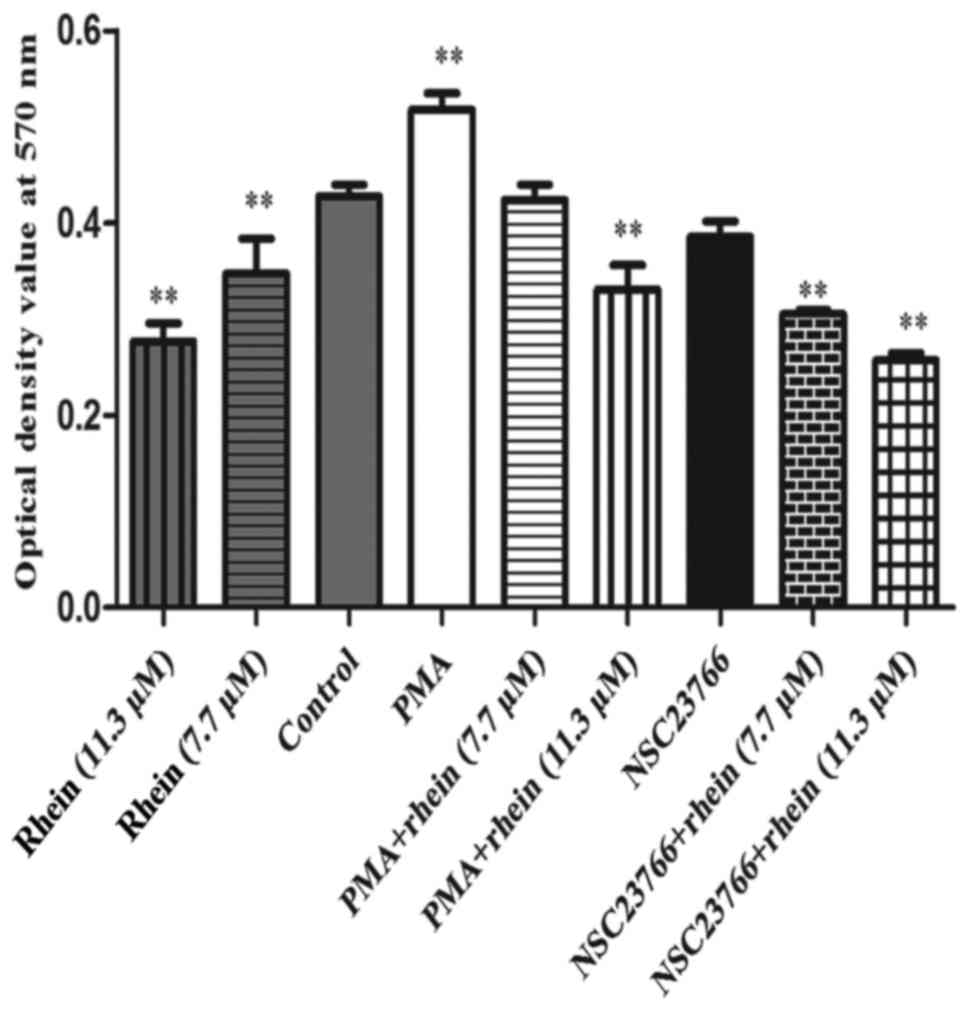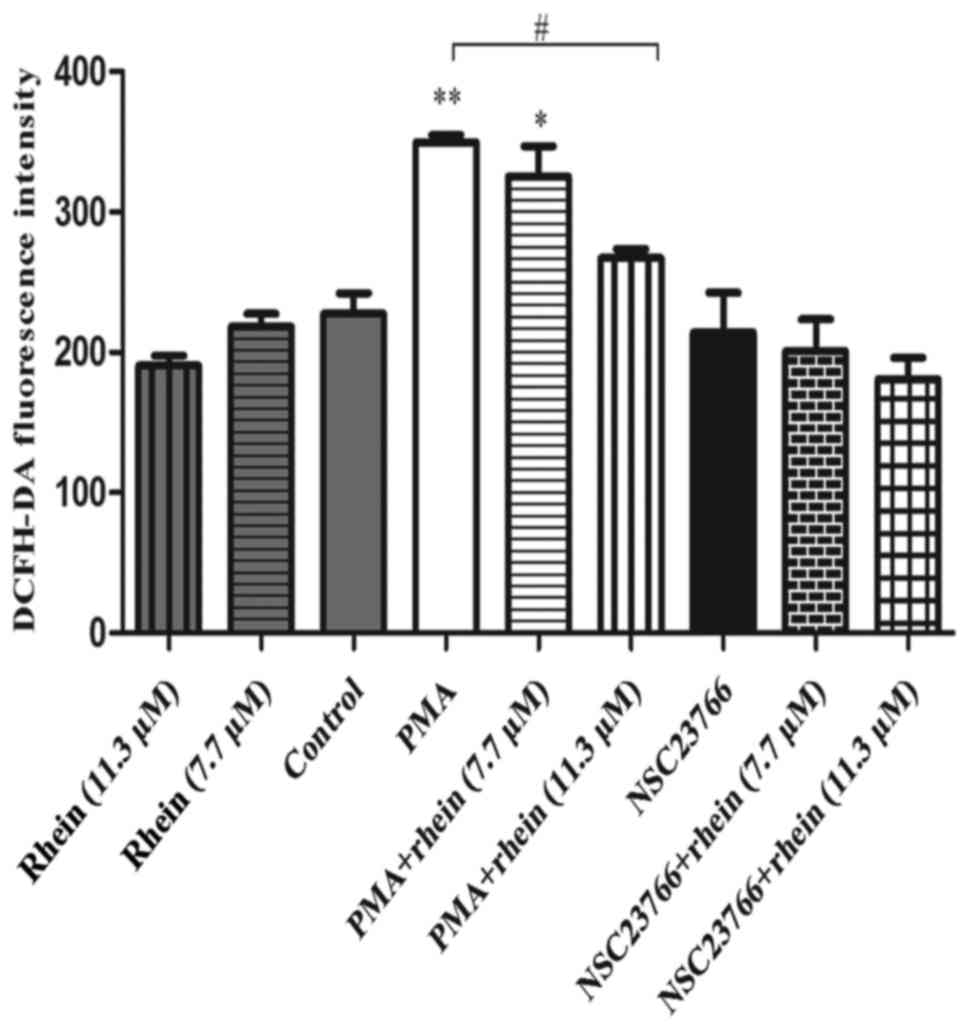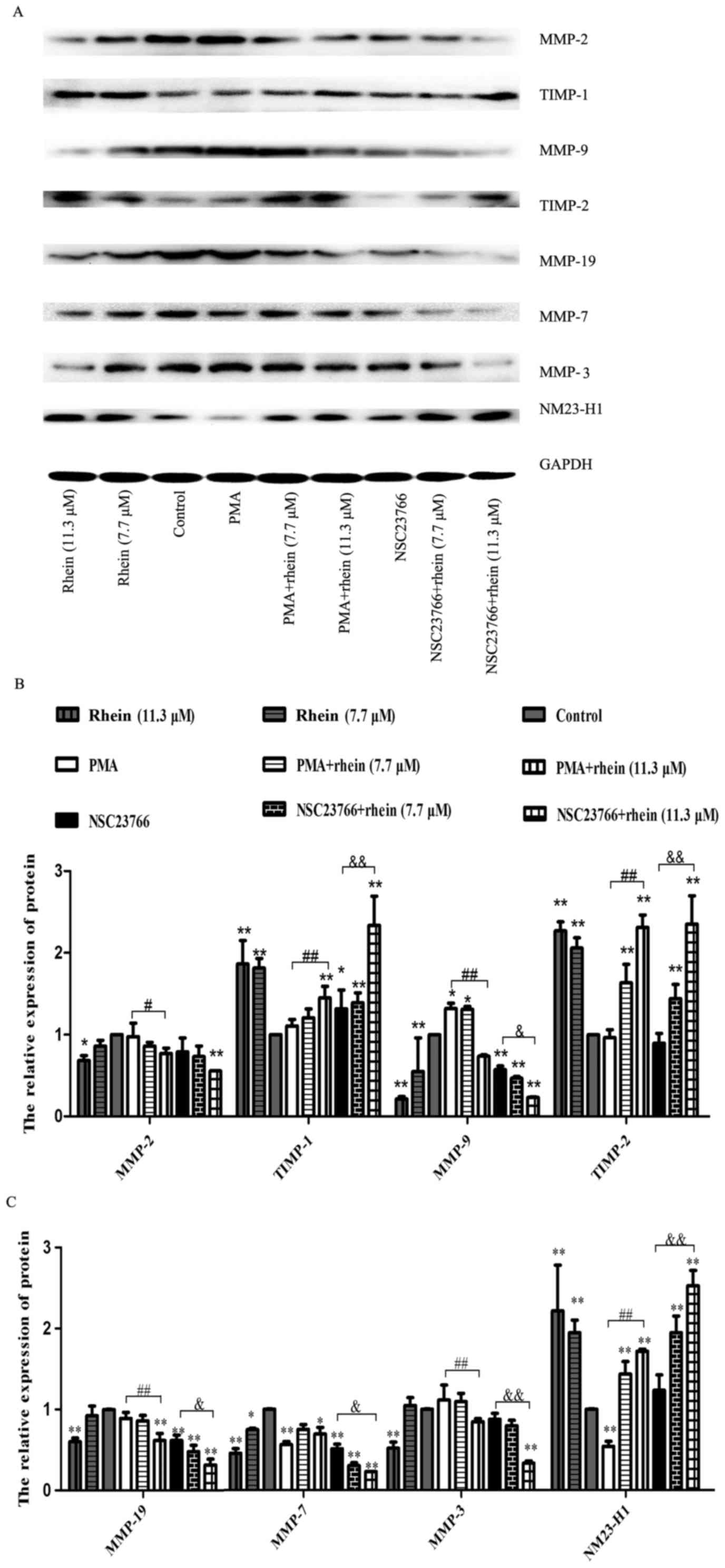Rhein suppresses matrix metalloproteinase production by regulating the Rac1/ROS/MAPK/AP-1 pathway in human ovarian carcinoma cells
- Authors:
- Published online on: January 17, 2017 https://doi.org/10.3892/ijo.2017.3853
- Pages: 933-941
Abstract
Introduction
Rac1, an important member of the small G protein family, influences cell migration and invasion by generating endogenous reactive oxygen species (ROS) (1,2). ROS, mainly generated from the NADPH oxidase, the cytochrome p450 and the mitochondrial electron transport system, are well known to regulate a variety of intracellular signal transduction pathways to mediate various biological responses, including cell proliferation, invasion and angiogenesis (3). Previous studies have reported NADPH oxidase catalytic subunit gp91phox and its homologues, the NOx family proteins, occur a series of changes and then transfer electrons through the plasma membrane to produce ROS, when the resting cell is stimulated by any of the variety of stimuli (4). Excessive ROS activate downstream signaling pathways to regulate expression of MMPs (5). Invasion and metastasis are fundamental properties of various malignant cancer cells. MMPs, a family of zinc-dependent endopeptidases, induce cancer cell invasion and spread through the degradation of the extracellular matrix (ECM) and the basal membrane (6). A balance between extracellular matrix (ECM) deposition and matrix destruction is important for maintaining normal tissues architecture and integrity. This balance is modulated by MMPs and their tissue inhibitors (TIMPs). MMP-2 (gelatinase-A) and MMP-9 (gelatinase-B) are essentially associated with elevated malignant cancer presence (7,8). MMP-3 plays a critical role in glioma invasiveness via degradation of hyaluronic acid-rich matrix of the brain (8). Research has shown that MMP-7 is overexpressed in epithelial ovarian cancer and triptolide inhibited the migration and invasion by repression of the expression of MMP-7 and MMP-19 in ovarian cancer SKOV3 cells (9). Based on these findings, controlling MMP expression has been proposed as an important therapeutic means for malignant tumor treatment and Rac1 has a number of downstream effectors including MMPS, ROS and mitogen-activated protein kinases (MAPK) (10,11). Therefore, RAC1 as a target is essential to control the migration and invasion of tumors.
Rhein (4,5-dihydroxyanthraquinone-2-carboxylic acid), extracted from rhubarb (Rheum palmatum L), has been found to possess various pharmacological effects, including anti-fibrosis, antioxidant (12,13), anti-inflammatory in LPS-activated macrophages (14) and antimicrobial activities (15). In addition, rhein exerts its anticancer effects via the modulation of processes of cellular proliferation (13), apoptosis, migration, and invasion (16). Earlier studies have demonstrated that rhein inhibited metastasis and invasion in human tongue cancer SCC-4 cells through downregulation of expression level of MMP-2 protein, and restrain the phosphorylation of c-Jun protein and c-Jun NH2-terminal kinase (JNK) and p38 kinase (17). Rhein in mouse skin JB6 epithelial cells inhibited 12-O-tetra-decanoylphorbol-13-acetate (TPA)-induced AP-1 activity and cell transformation by blocking JNK-dependent pathway, but did not restrain the phosphorylation of ERK and p38 MAPK (18). These data indicate that rhein may be another important component in rhubarb possessing antitumor activity.
Our research group found earlier (19) that rhein possess obvious growth inhibition on SKOV3-PM4 cells with directional highly lymphatic metastasis, but the underlying mechanisms of cell migration and invasion involved in the signal transduction pathway have not been elucidated. In this study, we demonstrated that rhein shows great inhibition of PMA-stimulated SKOV3-PM4 cell proliferation, migration and invasion by inhibiting the activity of Rac1 and its downstream ROS-dependent signaling pathway p38/JNK MAPK and decrease the expression level of transcriptional factor activator protein-1 (AP-1).
Materials and methods
Reagents
Rhein was purchased from Langze (Nanjing, China); phorbol 12-myristate 13-acetate (PMA, Cayman, MI, USA) and NSC 23766 (Selleck, Shanghai, China) were used as Rac1 activator and Rac1 inhibitor, respectively.
Cell culture and drug treatments
Human SKOV3-PM4 cell line was provided by the Oncology Laboratory at the Experimental Center of Guangxi Medical University (Nanning, China) and maintained in RPMI-1640 (Gibco; Life Technologies, Gaithersburg, MA, USA) supplemented with 10% fetal calf serum (Gibco) and 1% penicillin-streptomycin and then incubated at 37°C with 5% CO2 humidified atmosphere (20). The medium was changed every 2 days. PMA can activate the NADPH oxidase activity and NSC23766 inhibits its activity. No significant cytotoxicity to SKOV3-PM4 cells was found when the concentration of PMA and NSC23766 was 100 nM and 12.5 µM, respectively (21). Considering that the inhibitory rate of SKOV3-PM4 cells treated with rhein alone was <20%, the concentration of rhein was chosen as ≤11.3 µM. In exponential growth phase, SKOV3-PM4s were divided into nine treatment groups: group I (control); group II (7.7 μM rhein); group III (11.3 μM rhein); group IV (100 nM PMA alone); group V (PMA plus 7.7 μM rhein) group VI (PMA plus 11.3 μM rhein); group VII (12.5 μM NSC23766 alone); group VIII (NSC23766 plus 7.7 μM rhein); group IX (NSC23766 plus 11.3 μM rhein). Rhein was dissolved in dimethyl sulfoxide (DMSO) at a stock concentration of 176 mM. The final concentration of rhein was 0–20 μM with a maximal DMSO concentration <0.05% (DMSO has no effect on cell growth at a concentration <2%).
Cell proliferation assay
SKOV3-PM4 cells were allowed to grow in 96-well plates at 5,000 cells/well for 24 h and then treated with different concentrations of rhein, respectively. Forty-eight hours later, 20 μl of 5 mg/ml MTT solution was added to each well. The plates were incubated at 37°C in 5% CO2 for 4 h, then the supernatant was discarded and 150 μl DMSO was added to dissolve the formazan. The absorbance at a wavelength of 490 nm was measured using a microplate reader (Thermo Fisher Scientific Inc., Waltham, MA, USA). The percentage of inhibition was calculated as follows: % inhibition = [1−(mean A of sample/mean A of control)] ×100%.
Wound healing assay
SKOV3-PM4 cells were seeded in the plates at a density of 1×105/well and incubated for 24 h to form a monolayer with confluence. Cell motility was performed by wound healing assay. Briefly, the cells in the different groups, as described above, were scraped with a 10-μl pipette tip running through the center of the well and washed twice with PBS. RPMI-1640 medium with no serum treated in the different groups as described previously was added to the wells. SKOV3-PM4 cells were grown at 37°C for indicated times and images were taken.
Cell invasion assay
The invasion ability of the SKOV3-PM4 was assessed using the Matrigel Invasion assay (Sigma-Aldrich, St. Louis, MO, USA). Briefly, cells were adjusted to a density of 5×103 cells/ml with a series of drug solutions, as described above. Subsequently, 200 μl of cell suspensions in serum-free RPMI-1640 medium from different groups was seeded into the upper chamber of the Transwell insert (8-μm pore size; Costar, Acton, MA, USA), and the RPMI-1640 medium containing 20% FBS was added to the lower chamber. Cells were removed following incubation for 48 h at 37°C in 5% CO2. The Matrigel was wiped with a cotton swab and the cells were fixed with 95% ethanol for 20 min prior to staining with 2% crystal violet. Also, cells were imaged and counted under a light microscope.
Nitroblue tetrazolium assay
The SKOV3-PM4 cells were seeded in 6-well plates and treated with drugs as previously described. In brief, cells in different groups were harvested by centrifugation and incubated in nitroblue tetrazolium (NBT) solution (2 mg/ml, Solarbio, Beijing, China) for 20 min at 37°C. Subsequently, 200 μl HCl (1 mol/l) was added at 4°C to terminate the reaction. After centrifugation, the supernatant was discarded and 100 μl DMSO was added to solubilize the formazan crystals. The solute was transferred to a 96-well plate and then mixed thoroughly before reading on a microplate reader at 570 nm (Thermo Fisher Scientific, Inc.). The NADPH oxidase activity was expressed as: (mean A of sample/mean A of control) ×100%.
ROS production
The level of oxygen-free radical was determined by flow cytometry using 2′,7′-dichlorodihydrofluorescein diacetate (DCFH-DA, Sigma). SKOV3-PM4 cells in different groups were incubated with DCFH-DA in RPMI-1640 media (1:1,000) for 20 min, respectively. The cells were then washed with phosphate-buffered saline (PBS) and cellular fluorescence was measured with a FACSCalibur flow cytometer (BD Biosciences, San Jose, CA, USA). Assays were performed three times independently.
Western blot analysis
After 48-h treatment with different drugs, the proteins of SKOV3-PM4 cells were collected and separated on 10% SDS-PAGE in Tris-glycine buffer. Electrophoresis was performed at a constant voltage of 100 V. The proteins were then transferred to NC membranes (Millipore, MA, USA) in a semi-dry blotter (Hoeffer, Canada). The membranes were incubated in blocking buffer [0.1% Tween-20 in phosphate-buffered solution (PBST) solution containing 5% skim milk] for 2 h, incubated with a primary antibody in a blocking solution overnight at 4°C. Primary antibodies against p-p38 (1:200, Abcam, USA); p38 (1:200, Abcam); p-JNK (1:200, Abcam); JNK (1:200, Abcam USA); p-AP-1 (1:200, Abcam); AP-1 (1:200, Abcam); MMP-2 (1:200, Abcam); MMP-3 (1:200, Abcam); MMP-7 (1:200, Abcam); MMP-19 (1:200, Abcam); TIMP-1 (1:500, Abcam), TIMP-2 (1:600, Abcam), NM23-H1 (1:200, Abcam) and GAPDH (1:2,000, Abcam) were used. After washing three times at 10-min intervals with PBST, anti-rabbit antibody solution (1:5,000 Abcam) was added to the membrane for 2 h. The secondary antibody solution was washed three times with PBST (each wash for 10 min at room temperature). The PBST was discarded and the membranes were scanned using the Odyssey infrared imaging system (LI-COR, Lincoln, NE, USA). The intensity of protein staining was determined with Quantity One software.
Statistical analysis
All experiments were performed at least in triplicate and repeated three times. Unless otherwise indicated, the results are expressed as the mean ± standard deviation (SD). Statistical analysis was performed by SPSS 16.0 (IBM Corp., Armonk, NY, USA). The results from the nine groups were compared by one-way analysis of variance (ANOVA) and two-way ANOVA was used for comparison of two independent variances among groups. For all statistical analyses, differences were considered to be statistically significant at P<0.05.
Results
Proliferation of SKOV3-PM4 cells was suppressed by rhein
The effect of rhein on the proliferation of SKOV3-PM4 cells was investigated by MTT assay. The inhibition ratio of the SKOV3-PM4 cells exposed to different concentrations of rhein is shown in Fig. 1. The results showed that rhein could significantly inhibit the proliferation of SKOV3-PM4 cells in a dose-dependent manner, with IC50 values of 35.2 μM. Non-toxic concentration of rhein was <12 μM. So we selected 7.7 and 11.3 μM rhein as the experimental concentration.
Rhein suppresses migration and invasion in SKOV3-PM4 cells
To investigate the effects of rhein on SKOV3-PM4 cell migration and invasion, the wound healing assay and the Matrigel-based Transwell invasion assay were performed. As shown in Fig. 2A and B, compared with control cells, PMA can enhance the ability of SKOV3-PM4 cell migration, but NSC23766 has no effect. Rhein significantly inhibited SKOV3-PM4 cell migration (P<0.01). The ability of SKOV3-PM4 cell migration was suppressed by treatment with PMA combined with rhein. NSC23766 plus rhein significantly inhibited the migration of SKOV3-PM4 cells compared to the control (P<0.01). In addition, the results of the wound healing assay were consistent with the Matrigel-based Transwell invasion assay (Fig. 2C and D). Taken together, rhein markedly inhibited cell migration and invasion, suggesting that rhein is an effective inhibitor for ovarian carcinoma cell invasion, migration and metastasis.
Rhein participates in NADPH oxidase deactivation
It is known that NADPH oxidase plays an important role in activating the generation of ROS (3,4). Rac1 can activate NADPH oxidase which results in corresponding cellular effects (2-4). An NBT assay (Fig. 3) demonstrated that Rac1 activator PMA remarkably increased the activity of NADPH oxidase (P<0.01), but in the cells treated with rhein (7.7/11.3 μM) alone, PMA plus rhein (11.3 μM) and NSC23766 plus rhein (7.7/11.3 μM), the activity of NADPH oxidase significantly decreased compared to the control (P<0.01). PMA significantly increased the activity of NADPH oxidase and this effect was also attenuated by rhein. Thus, NADPH oxidase induced by PMA can be suppressed by rhein.
Rhein downregulates migration and invasion of SKOV3-PM4 cells by scavenging intracellular reactive oxygen species (ROS)
ROS contribution to cell migration and invasion has been well documented (22). We therefore, speculated that rhein might suppress SKOV3-PM4 cell migration via scavenging ROS. Here, the generation of intracellular ROS was examined using a DCFH-DA probe. As shown in Fig. 4, the level of ROS did not change significantly after cells treated with rhein alone, NSC23766 alone or with NSC23766 combined with rhein. However, PMA can remarkably increase the intracellular ROS production as compared to control cells (P<0.01). In cells treated with PMA combined with rhein, the ROS levels were downregulated clearly compared to cells treated with PMA alone (P<0.05).
Inhibitory effect of rhein on Rac1 activation stimulates expression of MMPs
Previous studies reported that MMPs participate in the degradation of the extracellular matrix, which is believed to involve in the invasion and metastasis processes (23,24). Using western blot analysis, we found that in the cells treated with PMA, a Rac1 activator, the expression of MMP-9 in SKOV3-PM4 cells was upregulated, whereas the MMP-7 expression level was downregulated as compared to the control. The protein expression levels of MMP-2, -3, -7, -9 and MMP-19 in the cells treated with NSC23766 or rhein (11.3 μM) alone were remarkably reduced in comparison with the control, and their expression levels in the cells treated with PMA plus rhein (11.3 μM) also significantly reduced as compared to the cells treated with PMA alone. MMP-2, -3, -7, -9 and MMP-19 expression levels in the cells induced by NSC23766 combined with rhein were greatly lower than those in the cells induced by NSC23766 alone. NM23-H1 expression level was downregulated in the cells treated with PMA, whereas NM23-H1, TIMP-1 and TIMP-2 expression levels had no significant change in the cells treated with NSC23766 as compared to the control. In the cells induced by rhein, whether high or low concentration of rhein, the protein expression levels of NM23-H1, TIMP-2 and TIMP-1 were significantly enhanced as compared to the control. Similar results were also observed in the cells treated with rhein combined with NSC23766.
Rhein attenuates the increase of JNK and p38 expression and phosphorylation induced by ROS
It was reported that transcription factor AP-1 is regulated by MAPK and AP-1 is also known to be a key transcription factor of MMPs (22,25,26). Woo et al reported that activation of one or more MAPK pathways was often associated with the MMP expression in various cell types (26). In order to explore the relationship among Rac1, MAPK and AP-1, we determined the relevant protein expression levels using western blot analysis. As shown in Fig. 6, p-JNK and p-AP-1 expression levels were decreased in SKOV3-PM4 cells treated with rhein, whereas their expression levels were significantly enhanced in the cells treated with PMA. In the cells treated with NSC23766 alone, p-JNK and p-AP-1 expression levels decreased while JNK and AP-1 expression levels had no change. The p-JNK and p-AP-1 protein expression levels were both decreased in the cells induced by PMA combined with rhein as compared to PMA treatment alone. Similar results were also obtained in the cells treated with NSC23766 combined with rhein as compared to NSC23766 treatment alone. The protein expression levels of p38, p-p38 and JNK did not significantly change in any treatment group, except for rhein plus NSC23766 group. AP-1 expression level did not change in any treatment group. A stronger protein phosphorylation of JNK and AP-1 could be induced by a high concentration of rhein (11.3 μM), whether or not combined with NSC2376, as compared to the control group.
Discussion
Ovarian cancer is one of the most common malignant tumors of female reproductive system. Ovarian cancer is a highly metastatic disease with a lack of early clinical symptoms and effective diagnosis measures. Therefore, the 5-year survival rate is about 30–40% and the survival rate of patients with advanced stage ovarian cancer is still less than 20% (27). Ovarian cancer metastasis and diffusion include direct spread, lymph node metastasis, hematogenous metastasis and implantation metastasis (20), while lymph node metastasis is one of the most important indicators of biological characteristics in ovarian cancer patients (28,29). Ovarian cancer remains a formidable treatment challenge, as most patients with ovarian carcinoma are diagnosed at advanced stage of disease (30). Therefore, it is important to study the molecular mechanism of invasion and metastasis of ovarian cancer cells and there is an urgent need to develop effective therapeutic drugs for advanced stage ovarian cancer to inhibit lymph node metastasis of the ovarian cancer cells, which is of great significance to improve the quality of life of patients with advanced cancer.
Many studies have shown that rhein possess potent antioxidant and antiproliferative effects on various cancer cells (15). Furthermore, it has been shown that rhein induced apoptosis in SCC-4 cells (17). In our study, the results also showed that rhein significantly inhibited the migration and invasion of SKOV3-PM4 cells (Fig. 2). These findings suggest that rhein may be a powerful candidate agent to prevent ovarian cancer metastasis. However, the underlying mechanisms of the inhibition of SKOV3-PM4 cell invasion by rhein are not yet completely elucidated. Therefore, further studies are required.
The migration of cancer cells is pivotal for cancer invasion and metastasis (10,11,22). Cancer malignancy is proportional to the ability of cancer cell migration. Initially, we measured the effect of rhein on cell proliferation. As shown in Figs. 1B and 2, rhein can markedly inhibit not only the growth of SKOV3-PM4 cells but also the invasive and migration ability of these cells with a low-toxic concentration (12 μM) in vitro. Our findings also showed that rhein could decrease the expression levels of tumor metastasis-associated proteins such as MMPS family (Fig. 5), suggesting that the inhibitory effect of rhein on SKOV3-PM4 cell invasiveness is via decreased production of tumor metastasis-related proteins.
Rac1 is well recognized to play a key role in malignant tumor progression including migration, lamellipodia formation and cytoskeleton organization (10). Rac1 has a large number of downstream effectors and so it is critical to inhibit the invasion of the tumors as important targets. It is well known that Rac1 is the upstream signaling protein for NADPH oxidase-mediated ROS production (31). Of note, non-mitochondrial NADPH oxidase is the major source of PMA-induced ROS in these tumor cells and has regulating roles in various physiological and pathological processes (3,4,32,33). Here, we found that after PMA, activating Rac1 increased the levels of intracellular ROS indirectly, which induced activation of MAPK that contributes to cell migration and invasion. We also used NSC23766 to perform the same experiments. NSC23766, Rac1 inhibitor, inhibited Rac1 expression and disrupted the microfilament skeleton rearrangement (34), as well as in cell functioning, including cell growth, adhesion, migration and gene transcription. Consistent with our findings rhein and NSC23766 suppress the MAPK signaling responsible for migration and invasion of SKOV3-PM4 cells through the reduction of Rac1-mediated ROS. Here, incubation with NSC23766 demonstrated that ROS are also fundamental for MMP-mediated invasion by SKOV3-PM4 cells (Fig. 5).
There is substantial evidence showing that the ROS mediated MMP gene expression and regulated downstream signal molecules, which are involved in tumor invasion of mitogen activated protein kinase (MAPK) including serine/threonine kinases consisting of the c-Jun N-terminal kinases (JNKs), the extracellular signal-regulated kinases (ERKs) and the p38 kinase (22,35). It was reported that the transcription of MMP gene is regulated by upstream regulatory elements, including NF-κB and AP-1 binding sites (26,36). However, AP-1 is an essential transcriptional factor for the regulation of the MMP gene expression (36,37). It has been reported that AP-1 transcription modulate the expression of c-Fos in the gastric cancer cells (37). Some previous literature also reported in gastric cancer AGS cells that JNK is critically required for c-Jun activation, while ERK is the critical kinase for c-Fos activation (23). Since we discovered that JNK1/2 and P38 played essential roles in MMP expression via AP-1, we hypothesized that rhein may work through an inhibition of JNK1/2 or p38 to suppress MMP expression via AP-1. To verify our hypothesis, western blotting was performed to determine the effect of rhein on JNK1/2 or p38 phosphorylation. As shown in Fig. 6, our data showed that the PMA treatment led to a remarkable increase in JNK1/2 and AP-1 phosphorylation, while in the presence of PMA plus rhein JNK1/2 and AP-1 phosphorylation was clearly inhibited. Rhein and NSC23766 significantly reduced the phosphorylation of JNK and AP-1 expression in the cells treated with PMA. Based on the above conclusion, rhein suppressed mechanism of MMPs through the inhibition of the Rac1-ROS-p38/JNK MAPK-AP-1 signaling axis.
In conclusion, this study demonstrates that the reduction in the metastasis ability of rhein is at least partly due to the inhibition of the Rac1/ROS/MAPK/AP-1 pathway signaling and the decreased MMP expression. The critical role that we found for Rac1 in MMP activation, makes Rac1 attractive as a potential pharmacological target for antitumoral therapy in ovarian cancer. Therefore, our data collectively suggest that rhein may be a potential therapeutic agent for controlling ovarian cancer metastasis.
Acknowledgments
This study was supported by grants from the National Natural Science Foundation of China (no. 81360502) and Guangxi Natural Science Foundation (no. 2014GXNSFAA118225).
References
|
Park SJ and Jeon YJ: Dieckol from Ecklonia cava suppresses the migration and invasion of HT1080 cells by inhibiting the focal adhesion kinase pathway downstream of Rac1-ROS signaling. Mol Cells. 33:141–149. 2012. View Article : Google Scholar : PubMed/NCBI | |
|
Park SJ, Kim YT and Jeon YJ: Antioxidant dieckol downregulates the Rac1/ROS signaling pathway and inhibits Wiskott-Aldrich syndrome protein (WASP)-family verprolin-homologous protein 2 (WAVE2)-mediated invasive migration of B16 mouse melanoma cells. Mol Cells. 33:363–369. 2012. View Article : Google Scholar : PubMed/NCBI | |
|
Bedard K and Krause KH: The NOX family of ROS-generating NADPH oxidases: Physiology and pathophysiology. Physiol Rev. 87:245–313. 2007. View Article : Google Scholar : PubMed/NCBI | |
|
Babior BM: NADPH oxidase: An update. Blood. 93:1464–1476. 1999.PubMed/NCBI | |
|
Nelson KK and Melendez JA: Mitochondrial redox control of matrix metalloproteinases. Free Radic Biol Med. 37:768–784. 2004. View Article : Google Scholar : PubMed/NCBI | |
|
Velinov N, Poptodorov G, Gabrovski N and Gabrovski S: The role of matrixmetalloproteinases in the tumor growth and metastasis. Khirurgiia (Sofiia). 1:44–49. 2010.In Bulgarian. | |
|
Zheng H, Takahashi H, Murai Y, Cui Z, Nomoto K, Niwa H, Tsuneyama K and Takano Y: Expressions of MMP-2, MMP-9 and VEGF are closely linked to growth, invasion, metastasis and angiogenesis of gastric carcinoma. Anticancer Res. 26A:3579–3583. 2006. | |
|
Wang FQ, So J, Reierstad S and Fishman DA: Matrilysin (MMP-7) promotes invasion of ovarian cancer cells by activation of progelatinase. Int J Cancer. 114:19–31. 2005. View Article : Google Scholar | |
|
Zhao H, Yang Z, Wang X, Zhang X, Wang M, Wang Y, Mei Q and Wang Z: Triptolide inhibits ovarian cancer cell invasion by repression of matrix metalloproteinase 7 and 19 and upregulation of E-cadherin. Exp Mol Med. 44:633–641. 2012. View Article : Google Scholar : PubMed/NCBI | |
|
Nomura N, Nomura M, Mizuki N and Hamada J: Rac1 mediates phorbol 12-myristate 13-acetate-induced migration of glioblastoma cells via paxillin. Oncol Rep. 20:705–711. 2008.PubMed/NCBI | |
|
Kim Y, Lee YS, Choe J, Lee H, Kim YM and Jeoung D: CD44-epidermal growth factor receptor interaction mediates hyaluronic acid-promoted cell motility by activating protein kinase C signaling involving Akt, Rac1, Phox, reactive oxygen species, focal adhesion kinase, and MMP-2. J Biol Chem. 283:22513–22528. 2008. View Article : Google Scholar : PubMed/NCBI | |
|
Guo MZ, Li XS, Xu HR, Mei ZC, Shen W and Ye XF: Rhein inhibits liver fibrosis induced by carbon tetrachloride in rats. Acta Pharmacol Sin. 23:739–744. 2002.PubMed/NCBI | |
|
Aviello G, Rowland I, Gill CI, Acquaviva AM, Capasso F, McCann M, Capasso R, Izzo AA and Borrelli F: Anti-proliferative effect of rhein, an anthraquinone isolated from Cassia species, on Caco-2 human adenocarcinoma cells. J Cell Mol Med. 14:2006–2014. 2010. View Article : Google Scholar | |
|
Gao Y, Chen X, Fang L, Liu F, Cai R, Peng C and Qi Y: Rhein exerts pro- and anti-inflammatory actions by targeting IKKβ inhibition in LPS-activated macrophages. Free Radic Biol Med. 72:104–112. 2014. View Article : Google Scholar : PubMed/NCBI | |
|
Zhou YX, Xia W, Yue W, Peng C, Rahman K and Zhang H: Rhein: A review of pharmacological activities. Evid Based Complement Alternat Med. 2015:5781072015. View Article : Google Scholar : PubMed/NCBI | |
|
Chang CY, Chan HL, Lin HY, Way TD, Kao MC, Song MZ, Lin YJ and Lin CW: Rhein induces apoptosis in human breast cancer cells. Evid Based Complement Alternat Med. 2012:9525042012. View Article : Google Scholar | |
|
Chen YY, Chiang SY, Lin JG, Ma YS, Liao CL, Weng SW, Lai TY and Chung JG: Emodin, aloe-emodin and rhein inhibit migration and invasion in human tongue cancer SCC-4 cells through the inhibition of gene expression of matrix metalloproteinase-9. Int J Oncol. 36:1113–1120. 2010.PubMed/NCBI | |
|
Lin S, Li JJ, Fujii M and Hou DX: Rhein inhibits TPA-induced activator protein-1 activation and cell transformation by blocking the JNK-dependent pathway. Int J Oncol. 22:829–833. 2003.PubMed/NCBI | |
|
Tang M, Li H, Zhou G, Xie Y, Ruan H and Li D: Rhein inhibits the movement and invasion of human ovarian carcinoma cells through Rac1/LIMK1/cofilin signaling pathway. Chin Pharmacol Bull. 32:366–372. 2016. | |
|
Xie Y, Zhong Y, Gao T, Zhang X, Li LI, Ruan H and Li D: Human lymphatic endothelial cells contribute to epithelial ovarian carcinoma metastasis by promoting lymphangiogenesis and tumour cell invasion. Exp Ther Med. 11:1587–1594. 2016.PubMed/NCBI | |
|
Wang C, Pan Z, Hou H, Li D, Mo Y, Mo C and Li J: The enhancement of radiation sensitivity in nasopharyngeal carcinoma cells via activation of the Rac1/NADPH signaling pathway. Radiat Res. 185:638–646. 2016. View Article : Google Scholar : PubMed/NCBI | |
|
Jung JS, Ahn YH, Moon BI and Kim HS: Exogenous C2 ceramide suppresses matrix metalloproteinase gene expression by inhibiting ROS production and MAPK signaling pathways in PMA-stimulated human astroglioma cells. Int J Mol Sci. 17:4772016. View Article : Google Scholar : PubMed/NCBI | |
|
Xia Y, Lian S, Khoi PN, Yoon HJ, Joo YE, Chay KO, Kim KK and Do Jung Y: Chrysin inhibits tumor promoter-induced MMP-9 expression by blocking AP-1 via suppression of ERK and JNK pathways in gastric cancer cells. PLoS One. 10:e01240072015. View Article : Google Scholar : PubMed/NCBI | |
|
Shuman Moss LA, Jensen-Taubman S and Stetler-Stevenson WG: Matrix metalloproteinases: Changing roles in tumor progression and metastasis. Am J Pathol. 181:1895–1899. 2012. View Article : Google Scholar : PubMed/NCBI | |
|
Wang L, Kuang L, Pan X, Liu J, Wang Q, Du B, Li D, Luo J, Liu M, Hou A, et al: Isoalvaxanthone inhibits colon cancer cell proliferation, migration and invasion through inactivating Rac1 and AP-1. Int J Cancer. 127:1220–1229. 2010. View Article : Google Scholar | |
|
Woo JH, Lim JH, Kim YH, Suh SI, Min DS, Chang JS, Lee YH, Park JW and Kwon TK: Resveratrol inhibits phorbol myristate acetate-induced matrix metalloproteinase-9 expression by inhibiting JNK and PKC delta signal transduction. Oncogene. 23:1845–1853. 2004. View Article : Google Scholar | |
|
Siegel R, Naishadham D and Jemal A: Cancer statistics, 2013. CA Cancer J Clin. 63:11–30. 2013. View Article : Google Scholar : PubMed/NCBI | |
|
Pepper MS: Lymphangiogenesis and tumor metastasis: Myth or reality? Clin Cancer Res. 7:462–468. 2001.PubMed/NCBI | |
|
Lengyel E: Ovarian cancer development and metastasis. Am J Pathol. 177:1053–1064. 2010. View Article : Google Scholar : PubMed/NCBI | |
|
Olivier RI, Lubsen-Brandsma MA, Verhoef S and van Beurden M: CA125 and transvaginal ultrasound monitoring in high-risk women cannot prevent the diagnosis of advanced ovarian cancer. Gynecol Oncol. 100:20–26. 2006. View Article : Google Scholar | |
|
Wu WS: The signaling mechanism of ROS in tumor progression. Cancer Metastasis Rev. 25:695–705. 2006. View Article : Google Scholar : PubMed/NCBI | |
|
Storz P: Reactive oxygen species in tumor progression. Front Biosci. 10:1881–1896. 2005. View Article : Google Scholar : PubMed/NCBI | |
|
Ushio-Fukai M and Nakamura Y: Reactive oxygen species and angiogenesis: NADPH oxidase as target for cancer therapy. Cancer Lett. 266:37–52. 2008. View Article : Google Scholar : PubMed/NCBI | |
|
Chen QY, Zheng Y, Jiao DM, Chen FY, Hu HZ, Wu YQ, Song J, Yan J, Wu LJ and Lv GY: Curcumin inhibits lung cancer cell migration and invasion through Rac1-dependent signaling pathway. J Nutr Biochem. 25:177–185. 2014. View Article : Google Scholar : PubMed/NCBI | |
|
Shin I, Kim S, Song H, Kim HR and Moon A: H-Ras-specific activation of Rac-MKK3/6-p38 pathway: Its critical role in invasion and migration of breast epithelial cells. J Biol Chem. 280:14675–14683. 2005. View Article : Google Scholar : PubMed/NCBI | |
|
Lee HJ, Hwang E, Park B, Zhang M, Sun ZW, Lee DG, Park SY and Yi TH: Methanol extract of bitter melon alleviates UVB-induced MMPs expression via MAP kinase and AP-1 signaling in human dermal fibroblasts in vitro. Phytother Res. 30:1519–1526. 2016. View Article : Google Scholar : PubMed/NCBI | |
|
Pulverer BJ, Kyriakis JM, Avruch J, Nikolakaki E and Woodgett JR: Phosphorylation of c-jun mediated by MAP kinases. Nature 3. 53:670–674. 1991. View Article : Google Scholar |



